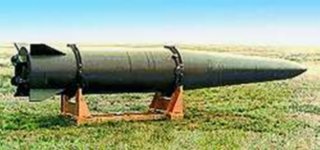




As of 1999 it appeared that this system had entered operational service with the Russian Army.
The launch installation has two missiles with a range of 280 kilometers. Each missile has a 480 kilogram warhead consisting of 54 elements. The system can be used against small and large targets. The Iskander missile can easily overcome air defense systems. It's almost impossible to prevent a launch of an Iskander missile because of the system's mobility. Targets can be found not only by satellite and aircraft but also by a conventional intelligence center and by a soldier who directs artillery fire. Targets can also be found from photos, which will be put into a computer by means of a scanner. The self-direction device functions even in fog or darkness. Only the Iskander system can accomplish such tasks. The United States has tried to reconsider the missile technology control regime and here arises the question whether this may be an obstacle for the sale of the new missile abroad. Such missile systems as Iskander have a special place in the world weapons market. Even a small amount of such missiles drastically changes the balance of force in conflicts. According to Nikolay Guschin, chief and senior designer of the Machinebuilding Design Office, the complex is meant ' for covertly preparing and launching effective missile strikes at small-size targets of particular importance. A specificity of this complex is the high level of automation in the pre-launch preparations little time required to make it ready, and the high precision of shooting. Research carried out by specialists from the leading Russian military science centers has shown that the lskander-E missile complex is 5 to 8 times better than its foreign analogues in terms of the "effectiveness-cost" criterion. As for its tactical and technical characteristics, it also poses a great improvement on the existing Russian tactical missile complexes. Capable of accomplishing tasks connected with the use of non-nuclear warheads, it's the world's first complex equipped with two-missile launch installation. Weighing 3800 kilos each, controlled throughout the trajectory of their flight, equipped with various systems of correction and self-targeting, its missiles are capable of overcoming the enemy's anti-missile defences and hitting targets at a distance of 280 kilometers. According to military experts, the lskander-E missile complex will serve as "determent weapon" in local conflicts, and as strategic arms for the countries with limited territory. Its great range of shooting making it possible to use it from the depth of one's own positions, and the brief time it can stay in its launch position make the complex virtually invulnerable to ordinary weapons. The composition of the complex makes it possible to ensure the full cycle of its use in combat, including its combat control, information base, technical servicing and the training of its crews, without the involvement of additional remedies.Specifications | |||||||
| DIA Code Name | SS-26 | ||||||
| Nato Code Name: | ? | ||||||
| Russian Designation: | Iskander | ||||||
| Design Bureau: | KBM Engineering | ||||||
| Inservice: | 1999 | ||||||
| Range: | 300 Km | ||||||
| Stages: | 1 | ||||||
| Warhead: | 480Kg - unitary or 10 Submutitions | ||||||
| Weight: | 3,800 Kg | ||||||
| Fuel: | Solid | ||||||
| Guidance: | GPS/GLONASS/Inertial/ Possibly IR Terminal Homing | ||||||

